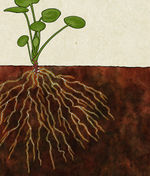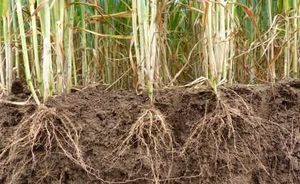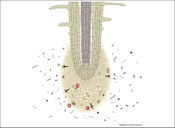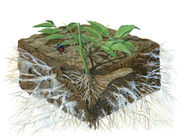Rhizosphere
Overview

- The rhizosphere is the portion of soil surrounding the roots of plants, and it is a hot spot for life. It is influenced by chemicals secreted by plants through their roots, called root exudation. Different plants secrete different things, so the environment is very unqiue to the local vegetation. Exudates can even alter the pH of the rhizosphere. The uniqueness of the rhizosphere from place to place and plant to plant explain the different types [microorganisms] that inhabit it.

[5]
Depending on the type of plant, the rhizosphere can extend 2-80 mm away from the roots. In the vicinity of roots, the soil is significantly wetter, and the high moisture levels protect plants from drying out and contribute to the dense population of [microorganisms]. Rhizodeposition is considered all the material lost from plant roots into the rhizosphere. This includes water soluble exudates, dead roots and root hairs, and gases, like carbon dioxide.
Root Exudation

- Root exudation is the process of chemical excretion from the roots of plants as a means of interaction with the other organisms in soil. Amino acids, carbohydrates, sugars, and vitamins are all examples of exudates. In order for a plant to survive and thrive, it must have the ability to detect and perceive changes in the local environment. It is also one of the most important factors affecting microbial life and growth. Root to root and root to microbe commmunication are two types of interactions that occur in the rhizosphere due to root exudation.
- Root to Root interaction includes the growth and development of other plants nearby. The chemical messages sent out in root exudation are signals to prevent invading roots.
- Root to microbe interaction can be used in both positive and negative situations. Positive communication is used in order to attract [mycorrhizal] fungi colonization on the root as well as nitrogen fixing bacteria. To create nodulation of fungi on their roots, the plants secrete flavonoids that attract the organisms. Negative communication is used when plants need to defend themselves from parasitic [microorganisms] and pathogenic bacteria. In these cases, defense proteins are secreted and continuously attack pathogens.
Habitat for Critters

- The rhizosphere supports a diverse and densely populated microbial community. The rhizosphere can vary greatly because different plants give off different signals in root exudation. This variance affects which [microorganisms] inhabit it. Pathogenic microbes invade and kill the plant. Symbiotic interactions are beneficial to the plant and microbe. Harmful microbes reduce plant growth, but not intentionally like pathogenic ones. Saprophytic microbes live off of dead roots and plants.
- Even though plants produce their own food through photsynthesis, they have trouble obtaining and absorbing essential nutrients, like nitrogen and phosphorus. [Mycorrhizal] fungi can easily obtain these nutrients, and since they live on plant roots, the plants can gain them as well. The fungi get carbohydrates from the plants that they use for energy, so the relationship between them is symbiotic.
References
- [1] Bishnoi, Usha. “Plant Microbe Interactions.” Advances in Botanical Research, 2015, [[1]].
- [2] Baetz, Ulrike, and Enrico Martinoia. “Root Exudates: The Hidden Part of Plant Defense.” Science Direct, Feb. 2014, [[2]].
- [3] Chadwick, Douglas H. “Mycorrhizal Fungi: The Amazing Underground Secret to a Better Garden.” Mother Earth News, 2014, [[3]].
- [4] Cheng, Weixin, and Alexander Gershenson. “Carbon Fluxes in the Rhizosphere.” The Rhizosphere, 2007, [[4]].
- [5] “Crop Gene Discovery Gets to the Root of Food Security.” Phys.org, 4 Dec. 2017, [[5]].
- [6] Lines-Kelly, Rebecca. “The Rhizosphere.” Soil Biology Basics, [[6]].
- [7] Koo, B-J, and CD Barton. “Root Exudates and Microorganisms.” Encyclopedia of Soils in the Environment, 2005, [[7]].
- [8] Pace, Matthew. “Hidden Partners: Mycorrhizal Fungi and Plants.” The New York Botanical Garden, [[8]].
- [9] Schley, Lacy. “That Word You Heard: Rhizosphere.” Discover, 11 Feb. 2019, [[9]].
- [10] Walker, Travis S., et al. “Root Exudation and Rhizosphere Biology.” Plant Physiology, [[10]].